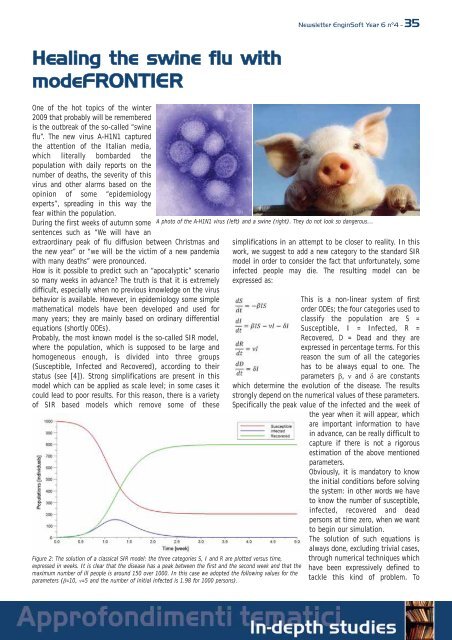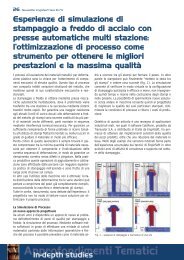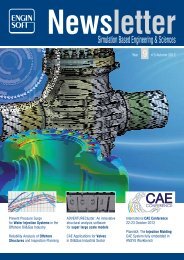software training courses 2010 corsi di addestramento ... - EnginSoft
software training courses 2010 corsi di addestramento ... - EnginSoft
software training courses 2010 corsi di addestramento ... - EnginSoft
Create successful ePaper yourself
Turn your PDF publications into a flip-book with our unique Google optimized e-Paper software.
Healing the swine flu with<br />
modeFRONTIER<br />
One of the hot topics of the winter<br />
2009 that probably will be remembered<br />
is the outbreak of the so-called “swine<br />
flu”. The new virus A-H1N1 captured<br />
the attention of the Italian me<strong>di</strong>a,<br />
which literally bombarded the<br />
population with daily reports on the<br />
number of deaths, the severity of this<br />
virus and other alarms based on the<br />
opinion of some “epidemiology<br />
experts”, sprea<strong>di</strong>ng in this way the<br />
fear within the population.<br />
During the first weeks of autumn some<br />
sentences such as “We will have an<br />
extraor<strong>di</strong>nary peak of flu <strong>di</strong>ffusion between Christmas and<br />
the new year” or “we will be the victim of a new pandemia<br />
with many deaths” were pronounced.<br />
How is it possible to pre<strong>di</strong>ct such an “apocalyptic” scenario<br />
so many weeks in advance? The truth is that it is extremely<br />
<strong>di</strong>fficult, especially when no previous knowledge on the virus<br />
behavior is available. However, in epidemiology some simple<br />
mathematical models have been developed and used for<br />
many years; they are mainly based on or<strong>di</strong>nary <strong>di</strong>fferential<br />
equations (shortly ODEs).<br />
Probably, the most known model is the so-called SIR model,<br />
where the population, which is supposed to be large and<br />
homogeneous enough, is <strong>di</strong>vided into three groups<br />
(Susceptible, Infected and Recovered), accor<strong>di</strong>ng to their<br />
status (see [4]). Strong simplifications are present in this<br />
model which can be applied as scale level; in some cases it<br />
could lead to poor results. For this reason, there is a variety<br />
of SIR based models which remove some of these<br />
Newsletter <strong>EnginSoft</strong> Year 6 n°4 - 35<br />
A photo of the A-H1N1 virus (left) and a swine (right). They do not look so dangerous…<br />
Figure 2: The solution of a classical SIR model: the three categories S, I and R are plotted versus time,<br />
expressed in weeks. It is clear that the <strong>di</strong>sease has a peak between the first and the second week and that the<br />
maximum number of ill people is around 150 over 1000. In this case we adopted the following values for the<br />
parameters (β=10, ν=5 and the number of initial infected is 1.98 for 1000 persons).<br />
simplifications in an attempt to be closer to reality. In this<br />
work, we suggest to add a new category to the standard SIR<br />
model in order to consider the fact that unfortunately, some<br />
infected people may <strong>di</strong>e. The resulting model can be<br />
expressed as:<br />
This is a non-linear system of first<br />
order ODEs; the four categories used to<br />
classify the population are S =<br />
Susceptible, I = Infected, R =<br />
Recovered, D = Dead and they are<br />
expressed in percentage terms. For this<br />
reason the sum of all the categories<br />
has to be always equal to one. The<br />
parameters β, ν and δ are constants<br />
which determine the evolution of the <strong>di</strong>sease. The results<br />
strongly depend on the numerical values of these parameters.<br />
Specifically the peak value of the infected and the week of<br />
the year when it will appear, which<br />
are important information to have<br />
in advance, can be really <strong>di</strong>fficult to<br />
capture if there is not a rigorous<br />
estimation of the above mentioned<br />
parameters.<br />
Obviously, it is mandatory to know<br />
the initial con<strong>di</strong>tions before solving<br />
the system: in other words we have<br />
to know the number of susceptible,<br />
infected, recovered and dead<br />
persons at time zero, when we want<br />
to begin our simulation.<br />
The solution of such equations is<br />
always done, exclu<strong>di</strong>ng trivial cases,<br />
through numerical techniques which<br />
have been expressively defined to<br />
tackle this kind of problem. To











